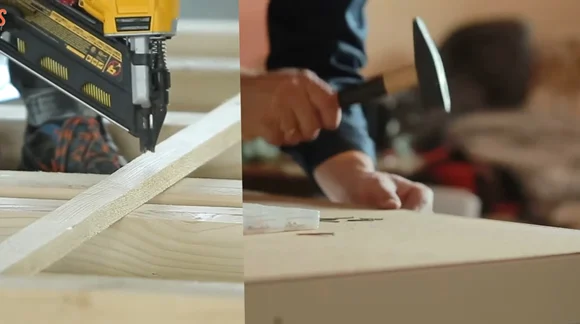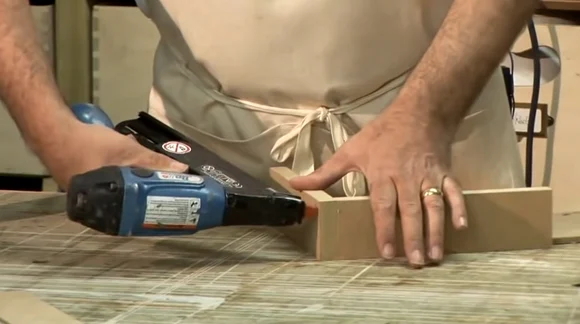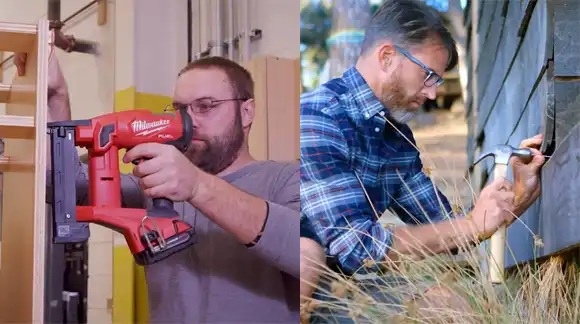Last Updated on January 11, 2023
It is possible to drive nails into wood with a variety of tools, but hammers and nail guns are the most commonly used. Nail guns can provide power and accuracy, but hammers prefer the old-fashioned method of swinging a hammer.
Using a nail gun is often the fastest option because it can drive nails into wood with one trigger squeeze. This can be a big time-saver, particularly on larger projects. A hammer is a classic tool for driving nails, and they are reliable. It’s relatively inexpensive, and no special equipment is needed.
Choosing the appropriate tool for a particular task is noteworthy, as every instrument has advantages and disadvantages. Here’s a breakdown of the differences between a nail gun and a hammer so you can decide which is right for you.
Nail Gun VS Hammer : Differences

When it comes to home improvement projects, there are a few essential tools that every homeowner should have on hand; a hammer and a nail gun. These are two of the most basic and necessary tools, but there is a debate over which is better. Here are some of the key differences between these two devices:
Types
A nail gun can be found in just over ten different types (such as brad nailer, roofing nailer, finish nailer, etc.), but there are two main types of nail guns: pneumatic nailer and cordless. Pneumatic nail guns are powered by air compressors, while batteries power cordless guns. Both types of nail guns have their pros and cons.
It is possible to find over 40 different types of hammers, including basic hammers, mallets, and specialty hammers. But most common are claw hammers, ball-peen hammers, and sledgehammers. Each type of hammer is designed for a specific purpose.
Size & Weight
A hammer is much smaller than a nail gun, making it easier to maneuver around tight spaces. Hammer also tends to be lighter, which can be important when working on large projects.
It has a handle that is usually made of wood, metal, or plastic and a head that is made of metal. The head of the hammer has a flat side used to hit the nails and a pointed side used to remove nails.
A nail gun is a powerful cordless or pneumatic tool that drives nails into wood or other materials. It has a handle that usually consists of metal or plastic and a head constructed from metal. So nail guns can also be less strenuous to use than hammers since you don’t have to swing your arm to drive the nails.
The commercial roofing nail gun has a trigger that is used to fire the nails and a magazine that holds the nails. The weight of the nail gun ranges from about 1 kg to about 5 kg.
Portability
One of the main advantages of a nail gun is portability. Most nail guns are relatively small and lightweight, making them easy to carry around and use in tight spaces. This is especially helpful when working on projects that require a lot of maneuvering, such as repairing trim or building a fence.
In contrast, hammers are often much larger and heavier, making them difficult to use in tight spaces. Also, the portability of nail guns makes them ideal for projects that require frequent breaks.
Accuracy
Regarding accuracy, there is no clear winner between nail guns and hammers. It all depends on the user’s skill level. A hammer requires a bit more precision, as the user has to hit the nail at the right angle to drive it into the wood.
On the other hand, with a nail gun, all you need to do is an aim in the general direction of your target. Pulling the trigger will drive the nail into the wood. Even so, this can also be a downside, as it is easy to misfire a nail gun and cause harm to the surrounding area.
Dependability
Nail guns are a quick and easy way to get the job done without all the hassle. But what about dependability? When it comes to long-term use, which is better, nail guns or hammers? While nail guns might seem like the clear choice for durability, they require more maintenance than hammers.
Over time, the mechanism that fires the nails can become jammed, making the gun unusable until it is repaired. As opposed to this, hammers are simple devices with no moving parts.
As long as you don’t lose the hammer-head, a hammer will last you a lifetime. So when it comes to dependability, neither is superior; it just depends on what you’re looking for.
Depth Control
When it comes to depth control, though, the hammer has a clear advantage. With a hammer, you can easily adjust the force you’re using to drive the nail, which gives you more control over how deep the nail goes into the wood.
By contrast, most nail guns have a depth adjustment knob that can be difficult to use accurately. As a result, it’s easy to accidentally drive the nail too deep, which can deteriorate the surface or make it difficult to remove the nail later on. For this reason, if you’re looking for precision, a hammer is the better option.
Speed and Force
A hammer is a lot slower than a nail gun and doesn’t have as much force. It takes a lot more effort to use a hammer than it does to use a nail gun. To nail something rapidly, you will want to use a nail gun.
If you’re trying to put a nail into something very delicately, you might want to use a hammer. It all depends on the situation that you’re in. You can get the job done faster with a nail gun, but there are some situations where a hammer is going to be better.
One or Two-Handed Use
Nail guns are operated with one hand, while hammers require two hands. This is an important distinction when considering which tool to use for a particular job. For example, if you’re doing work that requires both hands to be free, such as holding a piece of wood in place, then a nail gun is the better choice.
Conversely, if you’re only working with one hand or need more precision than a nail gun can provide, then a hammer is the better tool. A nail gun and hammer can also be used for some jobs, such as attaching the trim to furniture. In these cases, it’s often a matter of personal preference which tool to use.
Ease of Use
Many people think that a nail gun is much easier to use than a hammer, but that’s not always the case. This will depend on the task and your experience. For example, if you’re hanging picture frames or installing baseboards, a nail gun will be faster and easier than a hammer.
But if you’re trying to build a deck or fence, a hammer will probably be better since you’ll need more precision. And if you’re a beginner, it might be easier to start with a hammer so you can get a feel for how much force you need to use.
Cost
Cost often plays a significant role in choosing the right tool for a given task. Nail guns and hammers are both commonly used for driving nails into wood, but they vary significantly in price. A basic hammer can be purchased for just a few dollars, while a nail gun can cost several hundred.
Also, nail guns require the purchase of additional supplies, such as an air compressor, which can also add to the cost. Nail guns are much more efficient than hammers in speed and can also reduce the risk of injury.
For these reasons, nail guns are often used by professional contractors. But, a hammer is usually sufficient for smaller jobs around the house.
These are the most common differences between nail guns and hammers. You should consider your experience level and the specific task when selecting the correct tool. While hammers are generally preferred for precision work, nail guns are preferred for speed and force.
Why is a Nail Gun More Effective than a Hammer?

A hammer is a classic tool that has been used for centuries to drive nails into wood. But, in recent years, nail guns have become increasingly popular due to their superior accuracy and efficiency.
When using a hammer, it is easy to miss the target and hit your finger instead. Nail guns allow you to avoid this problem by providing a more precise aim.
Either compressed air or electricity powers nail guns, and they drive nails into the wood at a much higher speed than you could ever achieve with a hammer. This means you can complete hand-nailing tasks much more quickly and with less effort.
Plus, nail guns are much faster than hammers, so you can complete your project in a fraction of the time. Also, nail guns are much more precise than hammers, so you’re less likely to ruin the wood or injure yourself.
Lastly, nail guns apply more force than hammers, so the nails are less likely to slip out of place. For these reasons, it is clear that a nail gun is a more effective tool than a hammer. If you’re looking for a more efficient and enjoyable way to drive nails into wood, then a nail gun is the perfect tool for the job.
Why is a Hammer More Effective than a Nail Gun?
Nail guns are a staple of many construction projects, but there are times when a hammer is a better option. For one thing, a hammer can be used on a broader variety of materials, including wood, plastic, and metal.
Also, a hammer provides more control than a palm nailer, helping avoid collateral damage. And if something goes wrong, a missed nail with a hammer is less likely to cause serious injury than a misfired nail from a gun.
A hammer is more versatile, so you can use it to drive nails, remove nails, pry things open, and even pound out dents. Also, a hammer doesn’t require batteries or compressed air. That means you can use it even if there’s no power source nearby. Without a power supply, a nail gun is useless without power.
So next time you tackle a project, don’t reach for the nail gun first; consider whether a hammer might be the better option.
Nail Guns and Hammers: When to Use them

Though both are valuable tools, there are certain situations in which one is better than the other. For example, if you need to drive a series of nails into a piece of wood quickly and with little effort, then a nail gun is the tool for the job.
Meanwhile, if you need more control over the depth of each nail or you’re working with delicate materials, then a hammer will be more effective.
Anyone who has attempted to put up a shelf or assemble a piece of furniture knows that driving nails in straight can be a challenge. That’s where a nail gun comes in handy.
Using compressed air, a nail gun can drive a nail into wood with a single squeeze of the trigger. Particularly useful when dealing with large boards or tight spaces.
But, nail guns are not appropriate for every situation. When accuracy is required, such as when hanging pictures, it is best to use a hammer. Nail guns can also be dangerous if they are not used properly.
To avoid serious injuries, it is always advisable to hold the gun tip against the surface before squeezing the trigger.
FAQs
Let’s look at some frequently asked questions about nail guns and hammers:
Q: Can I use nail gun nails with a hammer?
It is possible to use nail gun nails with a hammer. The head of the nail is larger than a finish nail, so it will require a little more effort to drive into the material. The extra holding power may be worth the extra effort in some cases.
Q: Can you use a hammer instead of a brad nail gun?
If you do not have a brad nailer, you can use a hammer instead. In any case, unless you are an excessively skilled hammer user, this method should be avoided, as you risk damaging the workpiece or the tool.
Q: Can you put regular nails in a nail gun?
Yes, you can use regular nails with a nail gun, but they may not fire properly. Nail guns are designed to work with specific types of nails, so using the wrong type of nail may cause problems. Regular nails are too short or large to be compatible with most nail guns, so they may not enter the chamber correctly or may not be propelled with enough force.
Q: Do I need a nail gun for framing instead of a hammer?
A framing nailer is not strictly necessary for framing; a hammer will suffice. Using a nail gun will make the task much easier and faster. If you’re doing any kind of serious framing work, a nail gun is worth investing in.
Conclusion
A nail gun is quicker and easier to use, but if not used properly, it can be hazardous. Compared to nail guns, hammers are slower and require more effort, but they are far safer.
The appropriate tool for the job depends on the project you’re working on and your personal preferences. If speed and efficiency are top priorities, a nail gun is a way to go. But, if occupational safety is a concern, a hammer is the better choice.
By reading this article, you should now have a better understanding of when to use a nail gun and why you should use a hammer. Having gained this knowledge, you will be able to take on your next project confidently.



